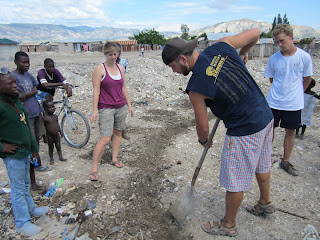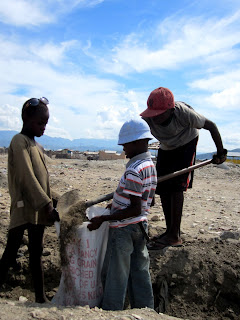What is an adobe house and why build one?I don't really know the exact definition of an adobe house, but the plan for the house in Gonaives is to use rice bags filled with dirt to makes the circular walls of a home. As the levels of bags get higher, the circles gradually get smaller until the bags meet at the top forming a dome. Inside and outside are skimmed with a thin coat of concrete to protect the bags. A gutter will collect rain water off the house, small windows act as vents and light sources, and a drainage ditch surrounding the house keeps it from eroding. The benefits are simple:
1. An adobe house is flood-proof and earthquake-proof.
2. The thick dirt bag walls keep the house cool.
3. All the supplies can be found or purchased locally - for example, we've bought our bags at the outdoor market, our dirt sifters were handmade from hardware supplies bought in Gonaives and our dirt is genuine dirt from the Jubilee dump.
4. If we do this right (fingers crossed), the adobe house will turn out to be a cheaper alternative to the concrete houses that are so common here, and far more durable than the tin houses or mud huts that fill Jubilee.
5. Building your own house is plain old fun!
I was in Gonaives 2 weeks ago for the ground-breaking.

And for the trench digging that will form the foundation of the house.


With used rice bags from the local market, we started laying our first sacks. My friends are paying 2 teenage boys to work with them, a system to help the boys go the afternoon school without simply giving them a handout. But beyond Jeff and Robenson, there is always a crowd around the work site. Children of all ages, their mothers, young men from the ghetto...and most people end up helping in some way or another, though it is interesting to note that the women and children are much more likely to pitch in than the adult men. Just an observation.




My biggest role that first week was rock gathering. In our original plan, we intended to use bags and rocks and cement as a sort of foundation, so I spent hours crouching in the dump collecting stones. The little kids seemed to think this great fun! At any given time, I had 5-10 kids holding out skirts, hats, cardboard boxes, stryrofoam plates, or little hands for me to fill them with rocks to dump in the trench. It was a repeat of the old classic Tom Sawyer whitewashing the fence and getting his friends to help.




Unfortunately, upon my return to Gonaives a few days later, I was told that the original plan had been thrown out and the new plan was the start laying sand bags in the normal fashion from the trench upwards. So all our rocks and all our first bags had to be removed. We bought unused bags for the sake of uniformity and laid a new first level, only to decide that our dirt quality was not good enough and our current trench was too large. So those bags got emptied too, we redug the trench a few feet smaller and we started sifting the dirt. My job, ironically, was to sit on dirt piles, pulling out by hand the very same rocks that we had collected a week earlier! The boys shoveled my hand-filtered dirt into a sifter and filled sacks with this superior dirt. And finally, the bags were laid just the way we wanted.


As of today, I am back in Port-au-Prince, living my normal life. Work will continue on the adobe house and I'm very excited to see how it goes!
